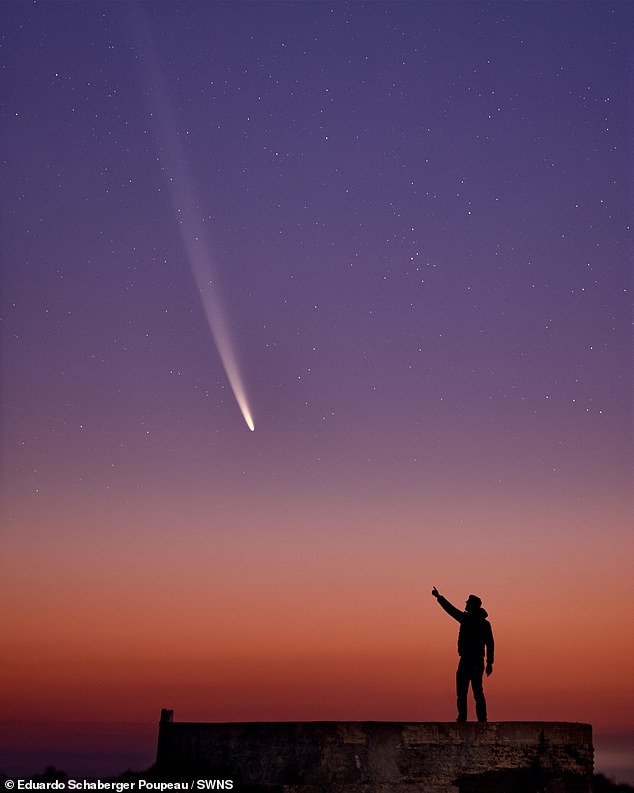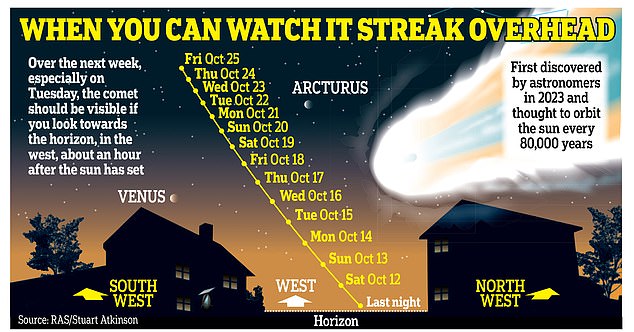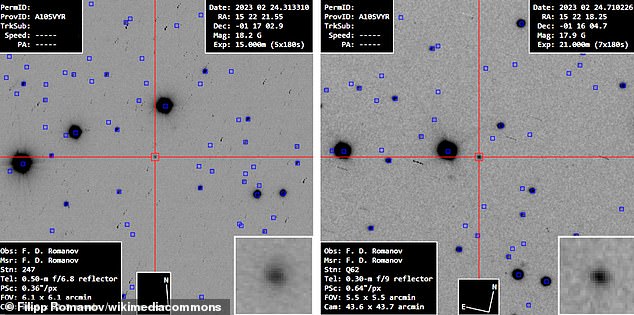See you in 80,000 YEARS! Comet not seen since humans migrated from Africa to the rest of the world is spotted over London in ‘once in a lifetime’ sighting
A comet that has not been visible from Earth since the age of Neanderthals has been spotted over London in a ‘once in a lifetime’ sighting.
Comet C/2023 A3 – also known as Tsuchinshan-Atlas – is believed to orbit the sun once every 80,000 years, making its current journey through our solar system the first since humans began leaving Africa.
It has now been spotted flying over the London skyline just after yesterday’s sunset, while it is 45 million miles away from Earth.
And in the coming days, it will travel so close to Earth that it should be visible to the naked eye – even without binoculars or a telescope.
A3 was last visible late last month, seen by stargazers in San Francisco across the Golden Gate Bridge – but experts say tonight is the best chance for Brits to see it for themselves before it disappears for generations.
It was spotted over the London skyline just after yesterday’s sunset while it is 45 million miles from Earth

Comet C/2023 A3, also known as Tsuchinshan-ATLAS, will cross British skies in the coming days (pictured in late September over Santa Fe, New Mexico)

The comet is in the middle of an 80,000-year journey to the solar system – seen here on September 22, captured from space by NASA astronauts Don Petit and Matthew Dominick

Comet C/2023 A3 (Tsuchinshan-Atlas) was last seen when Neanderthals walked Earth, experts say
This is because the comet has now passed the far side of the sun, meaning it is expected to be visible in Britain next week.
A3 was discovered by researchers last year and first observed at China’s Purple Mountain Observatory and an Atlas (Asteroid Terrestrial-impact Last Alert System) telescope in South Africa. It is named after both observatories.
It is believed to have come from the Oort Cloud, a giant spherical ice shell that surrounds our solar system, is about 4.5 billion years old and could be as much as 40 kilometers in diameter.
Data from Heavenly life suggests that the comet is currently about 45 million miles from Earth, traveling at about 150,000 miles per hour.
Between tonight and tomorrow morning it will reach its point closest to Earth and will shine at a magnitude of +1 or +2 – similar to the north star Polaris, and not far below the visibility of planets such as Venus on clear nights.
The light of the sun will illuminate the two-pronged tail of dust and ice that follows it; in reality, gas and dust are released from the comet’s ice as it thaws near the sun. This makes it even easier to see at maximum brightness.
Dr. Gregory Brown, senior astronomy officer at the Royal Observatory Greenwich, said: ‘The comet itself comes from an extremely distant part of our solar system, a place called the Oort cloud.
‘It contains many pieces left over from the formation of the solar system. Every now and then one of those pieces gets pushed inward toward the solar system, where it could end up in a very, very long orbit.
‘These orbits can last extremely long: thousands of years. The estimate for this particular comet is that if it is in a stable orbit, its last path to the inner solar system was about 80,000 years ago.”

The comet looks like a dark streak in the Geneva sky here on Friday. It will not be seen again for 80,000 years as it leaves the vicinity of Earth

Images of comet C/2023 A3 (Tsuchinshan-ATLAS) acquired in February 2023, shortly after it was discovered, at distant telescopes by an amateur astronomer

Comets are large objects made of dust and ice that orbit the sun. NASA describes them as ‘remnants’ from the formation of the solar system 4.6 billion years ago (artist’s image)
Experts say your best chance of spotting A3 is to find a hill or an area without tall buildings or trees about an hour after sunset — away from streetlights and other sources of light pollution — and look west.
There are a host of astronomy apps available that should be able to help you map the night sky and see exactly where the comet will be.
Having a telescope or binoculars on hand can enhance your star spotting experience, but be prepared to see a ‘speck’ of light crossing the sky rather than a shiny shooting star.
It goes without saying that the weather in Britain can obscure your view – so if there are clouds in the sky you may have to use your imagination.
But if you don’t see it tonight, fear not. Dr. Brown of the Royal Observatory Greenwich thinks it will be visible in the skies over Britain until next week, especially on Tuesday.
